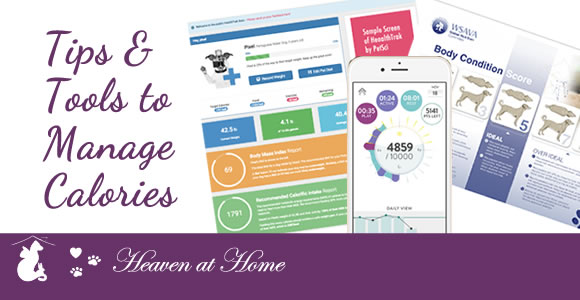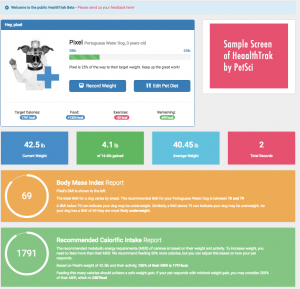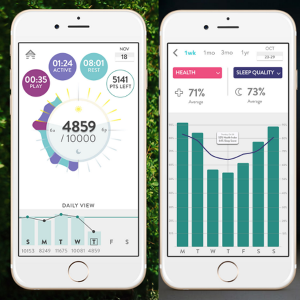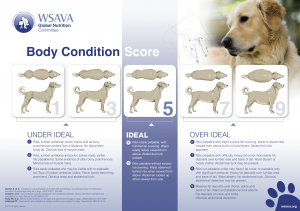 A pet parent who wants to optimize their aging pet’s health by preventing weight-gain but maintaining a healthy weight has two avenues to success – controlling the inputs and measuring the output. In other words, “Read, Feed and Weigh.”
A pet parent who wants to optimize their aging pet’s health by preventing weight-gain but maintaining a healthy weight has two avenues to success – controlling the inputs and measuring the output. In other words, “Read, Feed and Weigh.”
In this guide, we’ll help you gather some tools to figure out how much food your fur-baby needs to stay fit, from calories calculators and activity trackers to the Body Conditioning chart that helps you assess your pet’s score.
Calorie Calculators
To get a rough idea of calories required by your pet, you can use this embedded calculator from Plato Pet Foods, which is based on Ohio State University Veterinary Medical Center data. However, you can also consult with your routine care veterinarian for breed-specific and diet-specific advice. See our companion article about Feeding Your Senior Pet.
Online Pet Tracking for Weight & Calories Consumed
 One tool pet parents may find helpful is a new Pet Calorie tracker developed by PetSci in the UK. HealthTrak (https://petsci.co.uk/healthtrak/) is a (beta) online system that allows you to track the caloric intake of your pet against the ideal weight sought for your pet’s breed. If your current brand of food is not in the database, it’s easy to add it by looking up the nutrient profile online or on the bag. By tracking calories and weighing your pet weekly either at your veterinarian’s office or at home, you will be able to tell how well you’re doing with a general balance between MERs (Maintenance Energy Requirements) needed and Calories consumed.
One tool pet parents may find helpful is a new Pet Calorie tracker developed by PetSci in the UK. HealthTrak (https://petsci.co.uk/healthtrak/) is a (beta) online system that allows you to track the caloric intake of your pet against the ideal weight sought for your pet’s breed. If your current brand of food is not in the database, it’s easy to add it by looking up the nutrient profile online or on the bag. By tracking calories and weighing your pet weekly either at your veterinarian’s office or at home, you will be able to tell how well you’re doing with a general balance between MERs (Maintenance Energy Requirements) needed and Calories consumed.
Fitness Trackers for Pets – Show Calories Expended
 Another new device can give you further insight as to your pet’s caloric expenditure based on activity level. FitBark (https://www.fitbark.com/) is one of a few new Fit-bit style canine trackers that has a nice app interface that will show you Fido’s activity level, sleep quality, and approximate calories expended each day. The lightweight device is attached to your pet’s collar and shows results on your mobile phone. The data can be shared with your vet.
Another new device can give you further insight as to your pet’s caloric expenditure based on activity level. FitBark (https://www.fitbark.com/) is one of a few new Fit-bit style canine trackers that has a nice app interface that will show you Fido’s activity level, sleep quality, and approximate calories expended each day. The lightweight device is attached to your pet’s collar and shows results on your mobile phone. The data can be shared with your vet.
But you don’t have to go high-tech to get the job done. Reading the label for true calories per cup and then feeding according to weight management charts available from your vet or online will help you manage your pet’s weight.
Online Resources include:
- How to read Pet Food Labels for caloric values, visit: https://talkspetfood.aafco.org/readinglabels
- For commercial pet food calorie calculation: https://petsci.co.uk/healthtrak/
- For general scientific calculations: https://vet.osu.edu/vmc/companion/ourservices/nutrition-support-service/basic-calorie-calculator
- For articles on pet nutrition: http://vetnutrition.tufts.edu/
Body Scoring – How to Tell If Your Pet is Obese
 A Body Scoring Chart (BCS) is your vet’s “go-to” chart for identifying obesity in dogs and cats. Charts are graded on either a five-point or nine-point scale, and are available for both dogs and cats.
A Body Scoring Chart (BCS) is your vet’s “go-to” chart for identifying obesity in dogs and cats. Charts are graded on either a five-point or nine-point scale, and are available for both dogs and cats.
A BCS is based on four criteria: how easily felt the ribs are, how obvious the waist and abdominal tuck is, how much excess fat is beneath the skin and how much muscle mass is present. For a dog to score in the healthy range, the ribs should be easy to feel (but not see) and a defined waist, or “abdominal tuck,” should be evident when your dog is viewed from the top and side respectively. Depending on the thickness of your dog’s coat, you might have to feel for a defined waist or tuck if it is not readily visible.
Download a PDF of a full body condition scoring chart here from the American Animal Hospital Association that includes BOTH Dogs and Cats and shows BOTH styles of scoring points with the illustration: https://www.aaha.org/public_documents/professional/guidelines/weightmgmt_bodyconditionscoring.pdf
The Science Behind Calculating Energy Requirements
If you’re interested in the formula vets use to calculate Resting Energy Requirements or RER, it’s this: The animal’s body weight in kilograms raised to the ¾ power by 70.
For example, a 10kg (22lb) adult neutered dog of healthy weight needs RER = 70(10kg)3/4 ≈ 400 Calories/day. The RER is then multiplied by factors to estimate the pet’s total daily energy needs. Eg. Active, working dogs require 2.0 – 5.0 the RER; puppies 4 mos. to adult require 2.0 the RER, and inactive/obese-prone dogs require 1.2-1.4. Senior dogs typically need 1.2-1.4 RER, and cats approximately 1.5.
